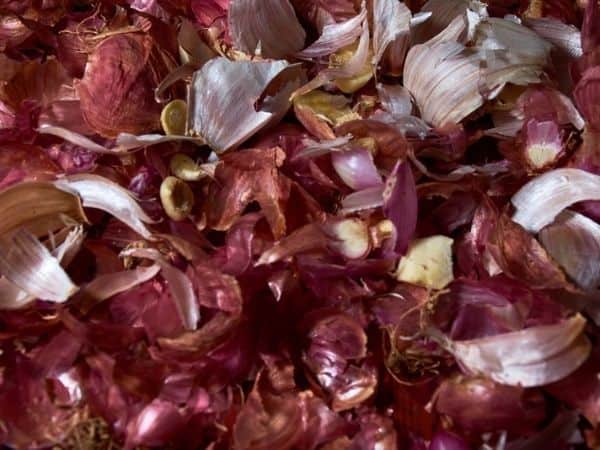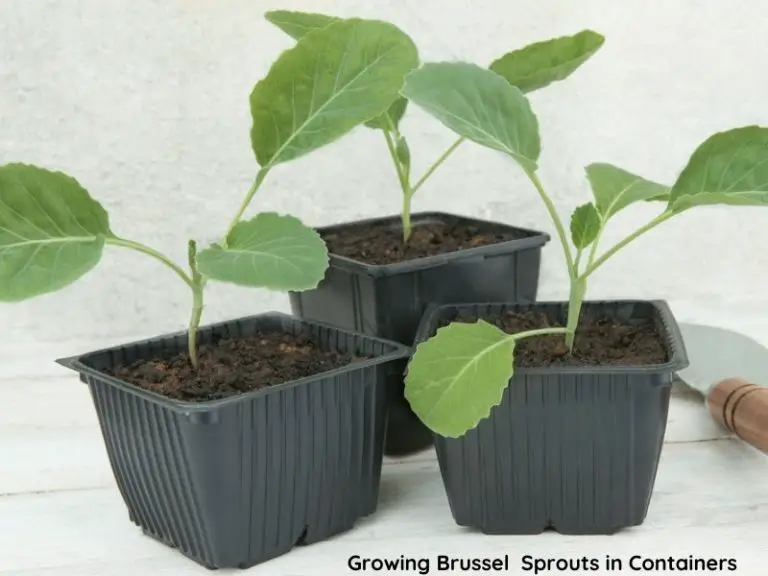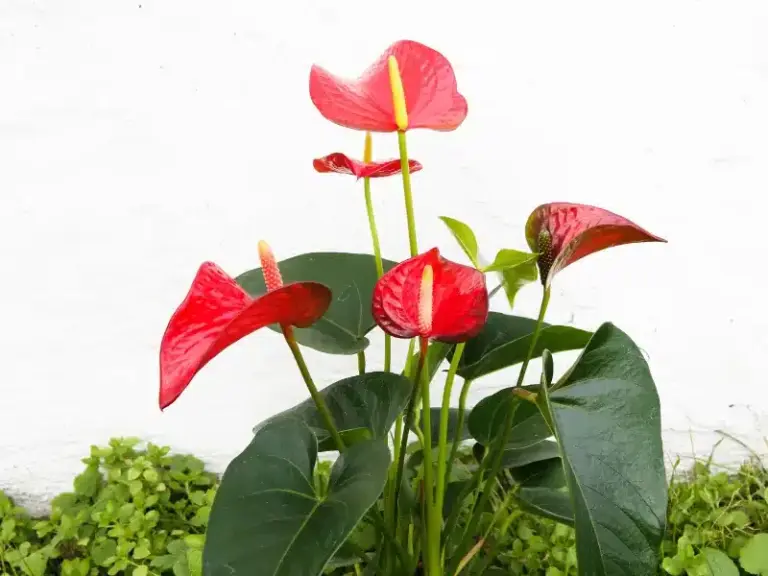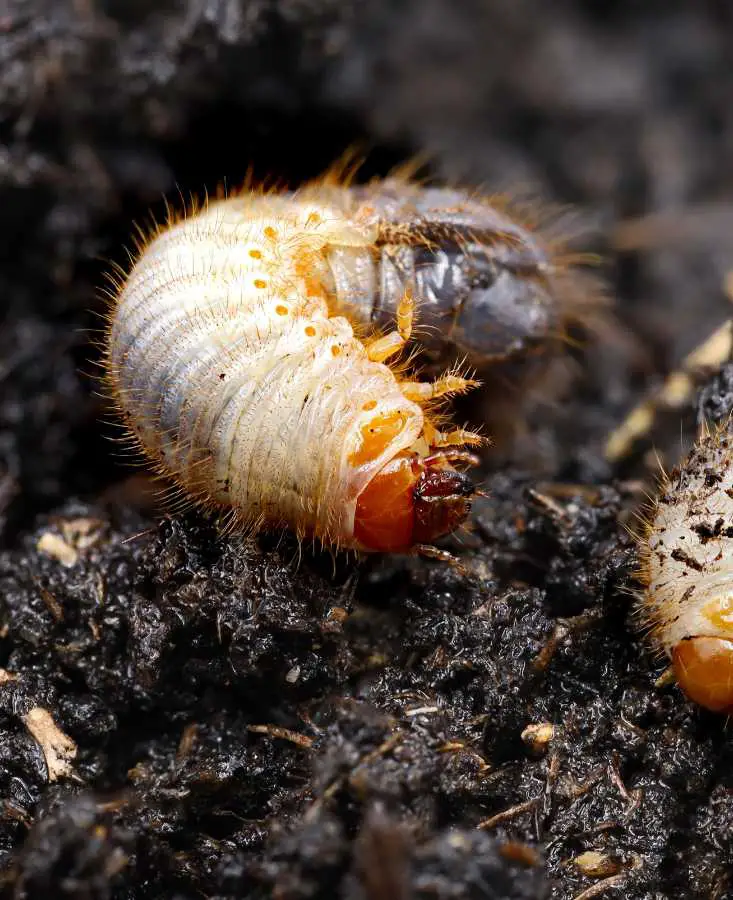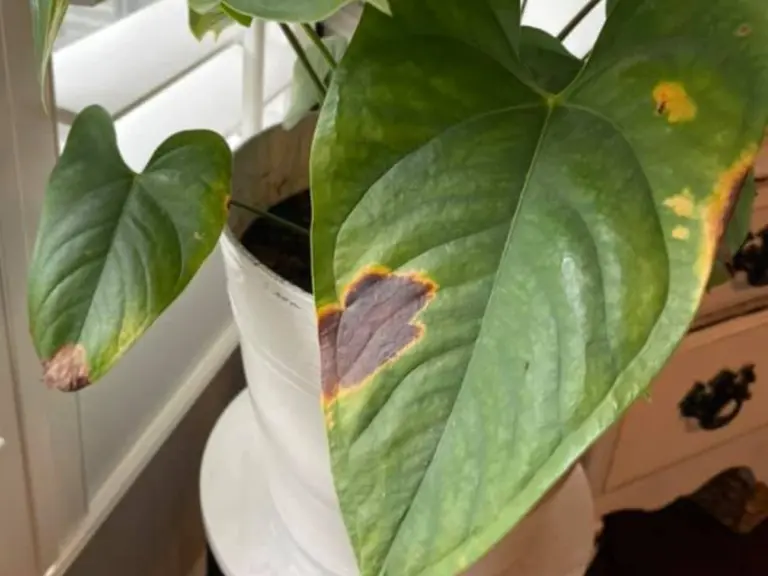Expert Advice on How to Get Anthuriums to Bloom
With their exotic heart-shaped leaves and vibrant flowers, anthuriums (Anthurium sp) are an attractive addition to any indoor garden. However, getting them to bloom consistently can sometimes be challenging.
In my experience, the only real way to ensure your anthuriums bloom yearly is by giving them the ideal conditions possible to reduce common stressors. This allows them to push the most energy possible toward creating new flowers.
In a nutshell, anthuriums won’t bloom if they don’t receive enough water, sunlight, and nutrients. To encourage anthuriums to bloom, water the plant only when the top inch of soil feels dry, provide bright indirect light, and supplement your soil with a phosphorus fertilizer.
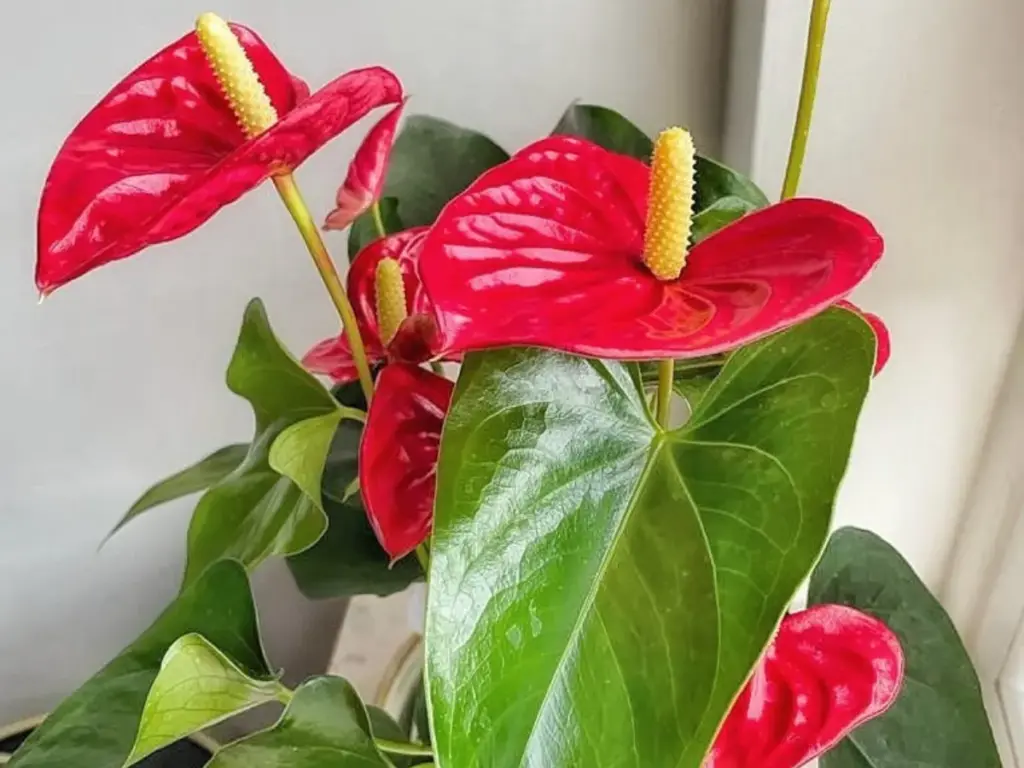
See my best anthurium care tips here.
Why anthuriums fail to bloom
Indoor anthuriums are especially prone to not flowering since they need very good care to produce flowers regularly. In general, unhappy anthuriums will not bloom Also, smaller, younger, diseased, and neglected plants will fail to bloom.
Here are the main reasons for not blooming:
Improper watering
Overwatering or underwatering anthuriums can disrupt their blooming cycle. The flamingo lily blooms best in moderately watered soils that dry out before the next watering. If the soil is too dry or soggy, the plant becomes stressed and won’t bloom.
Low light conditions
Neil Anderson, a horticulture professor and University of Minnesota Extension specialist, notes that a sure sign of insufficient light is “unusually long spaces on the stems between the leaf nodes (the point where a leaf grows out from the stem).”[1] This is typical with plants that love plenty of light growing under shade.
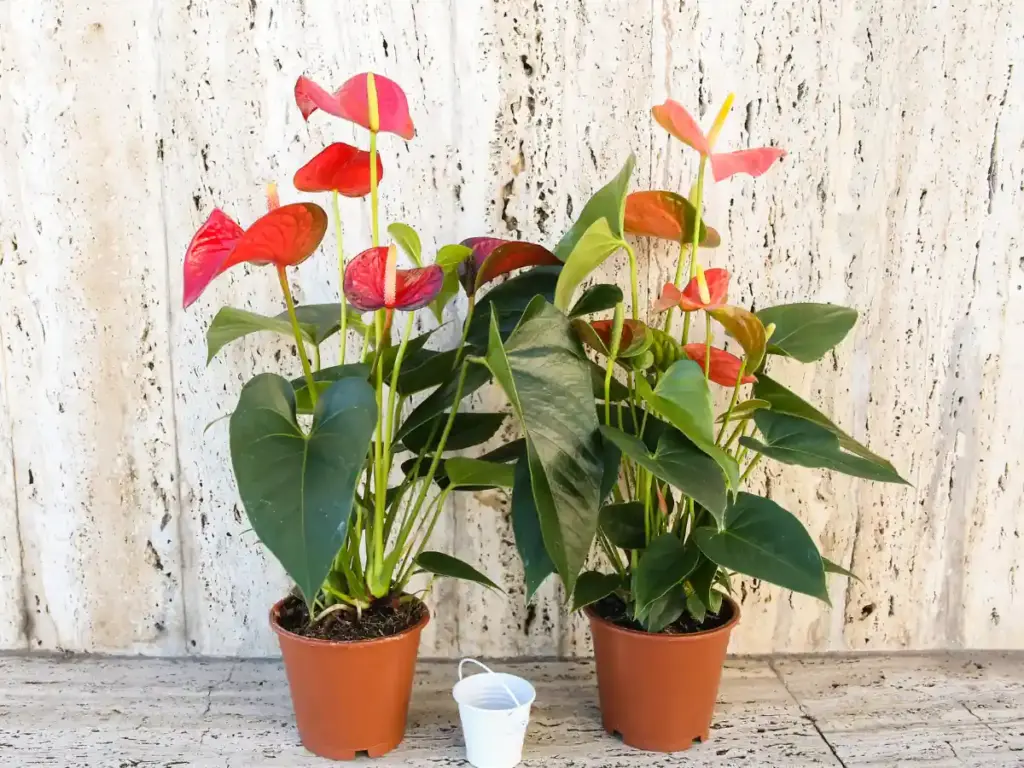
Excessive fertilization
If all other conditions are correct, yet the plant isn’t flowering, then it might not be getting enough nutrients. It could also be that the plant is being overfertilized.
Vigorous vegetative growth could indicate too much nitrogen, which promotes new growth and foliage rather than flowering.
I recommend decreasing the rate of fertilization to fix the problem. Once the excess nitrogen is washed away from the soil, your anthurium will bloom again.
The plant is not mature yet
Like many plants, anthuriums must pass through the juvenile stage of growth before they can bloom. If you recently bought your anthurium from a local nursery, it is possible that it is still growing and is characterized by the heavy growth of new leaves and shoots.
This is normal, and the flamingo plant will bloom as soon as it matures. Just give it time and proper care.
Anthuriums reach maturity when they’re about four years old. You must keep providing the plant with consistent native-like conditions until it reaches its peak blooming age.
How to get anthuriums to bloom over and over
Different cultivars of anthuriums have lasting inflorescence when their near-native conditions are maintained. Failure to bloom is a common pointer of negligent plant care and maintenance.
You can boost an anthurium’s chances of blooming by following these tips:
1. Provide bright indirect light
Anthuriums thrive best in bright but indirect sunlight. Too much direct sunlight can burn the leaves, while too little can inhibit blooming.
If your anthurium is not blooming, place it where it will receive consistent bright indirect sunlight to encourage it to bloom. An east, west, or south-facing window is ideal. Reflected bright light is a good source of light for the plant.
Avoid overexposure as it can lead to scorched anthuriums with brown leaves.
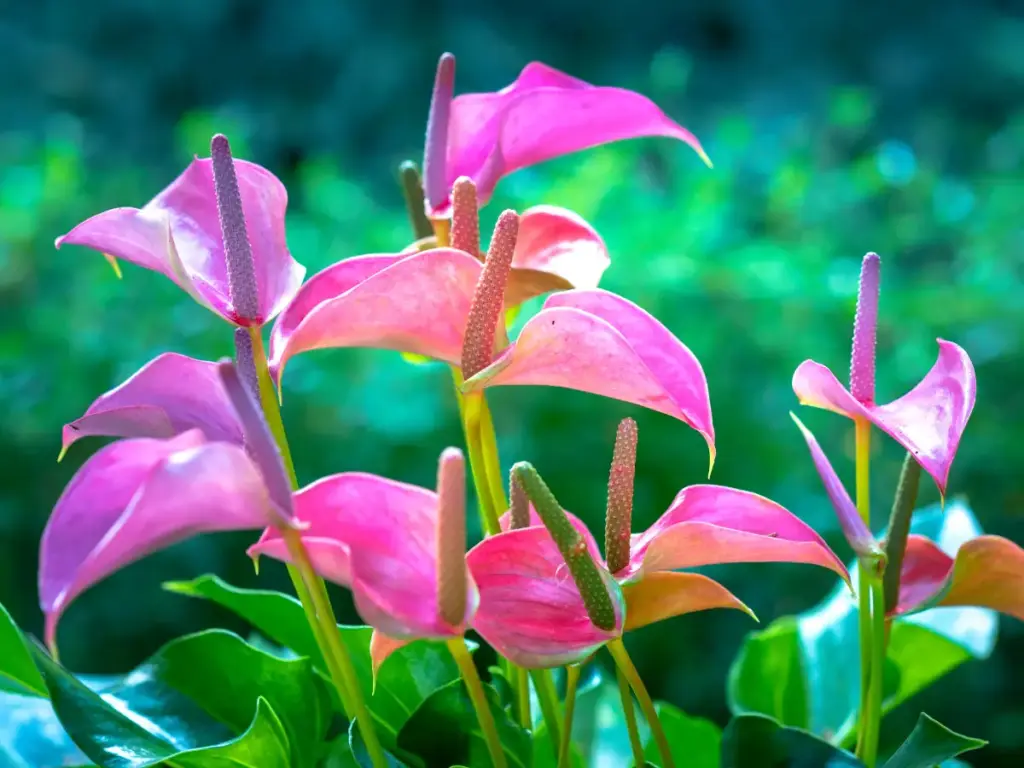
Author note: Light plays a key role in flowering plants regardless of whether they are photoperiodic or not.[2] Chemical transformations that trigger flowering depend on a signal that is light (or darkness). Therefore, ensure anthuriums get plenty of bright indirect light for at least 6 hours daily to make them bloom.
2. Water the plant regularly
Anthuriums prefer slightly moist soil, but they don’t tolerate waterlogged conditions. Allow the top inch of soil to dry out between waterings, and then water thoroughly. Ensure proper drainage to prevent waterlogging.
Keep the soil consistently moist, but be careful not to overwater. Overwatering can lead to root rot, which can prevent blooming.
Simply insert your index finger into the soil to determine if it is moist or dry.
Expert tip: As a rule of thumb, water the plant weekly or when the top inch of soil is dry. Half a cup of water weekly is enough to keep your anthurium hydrated. Also, water the plant daily in summer and just once a week when transpiration is low in seasons such as winter.
To further fix the watering problem, ensure your soil is well-draining. If you grow your houseplant in a pot or planter, ensure the soil hasn’t compacted over the growing season.
Also, have at least one large drainage hole at the bottom of the pot. Personally, I prefer a container with at least 4 mid-sized drainage holes to compensate for potential clogs.
3. Provide a warm environment
Next, make sure your anthurium is in a consistently warm environment. Ideal day temperatures should be somewhere in the 60-85°F range, while nighttime temps shouldn’t drop below 60°F. If there’s a cold front moving in, consider bringing your anthurium inside for the night to shelter it.
Also, ensure to keep the plant away from air conditioners and running fans, as they lower the temperature around it. Alternatively, you can increase the temperature during winter by using grow lamps.
While many anthurium varieties bloom year-round, they tend to bloom when temperatures and humidity are higher, which is why summer months see the most blooms in most states.
4. Feed the plant regularly
For those fussy anthuriums that have trouble blooming, consider supplementing the soil with some phosphorus to encourage blooms. Plants use phosphorous to form new roots, seeds, fruit, and flowers.[3]
If yours isn’t blooming, conduct a soil test to see if it is getting enough phosphorus. It likely isn’t.
Apply a diluted liquid fertilizer that is high in phosphorus (such as 10-20-10) once a week during the growing season (spring and summer) and once a month during the dormant season (fall and winter).
A fertilizer I recommend is the E-Z Gro blossom booster 10-30-20 fertilizer that we use in nurseries to speed up flower production in mature plants.
Follow the instructions on the label for the dosage and frequency. Don’t over-fertilize your plant, as this can harm it more than help. In fact, too much nitrogen fertilizer makes the plant grow excessive foliage, which prevents it from blooming, as most of the energy is diverted toward leaf development.
5. Try ethylene gas
Ethylene gas is a great way to get mature anthuriums to bloom, especially if you’ve tried other methods and had no luck. Ethylene is a naturally occurring plant hormone that triggers flowering in potted plants.
Place ethylene-producing fruits like apples, bananas, or tomatoes in a paper bag near your anthurium plant. These fruits naturally emit ethylene gas as they ripen. Loosely cover the fruits and the plant with a clear plastic bag and leave overnight. In the morning, remove the fruits and continue providing your anthurium with regular care.
Over time, exposure to ethylene gas may help trigger blooming in anthuriums.
6. Repot the plant
The potting mixture can become compacted over time and impair the plant’s ability to absorb water and nutrients. The soil will also get saturated with salts if it stays unchanged for a long time and inhibit your anthurium’s ability to absorb oxygen and other nutrients.
It is advisable to repot the plant after every two years or when it becomes root-bound and some roots appear to grow into the air. Always transfer the plant to a slightly larger pot.
7. Increase humidity
An anthurium plant thrives in relative humidity of about 50%. Low humidity can stress the houseplant and make it fail to bloom.
A good remedy is to place the plant in a well-lit bathroom where it will get plenty of humid air. Alternatively, mist the leaves with distilled water 2-3 times daily to keep the plant happy.
Placing a plant humidifier near your anthuriums is also a great fix for busy plant lovers who want to provide the perfect conditions and help their plants bloom.
8. Prune and deadhead
Another hack is to prune spent flowers and old foliage regularly to encourage the plant to concentrate its energy on making new leaves and flowers. Simply trim the entire stalk from the base of the stem in the fall.
Make sure to prune the older leaves and buds to encourage new growth that will bloom again. We encourage deadheading unhealthy flowers and damaged leaves instead of leaving them to fall off the plant by themselves.
Remember, weak flowers, stems, and foliage will attract pests, insects, and diseases on anthuriums.
If all else fails, setting the perfect indoor stage is an option, but this may require grow lights, humidifiers, or alternative growing methods/mediums. For example, semi-hydroponic systems are always interesting and produce better results in flower farms and nurseries.
FAQ
How often do anthuriums bloom?
With proper care, anthuriums can bloom all year. Each bloom lasts two to three months, bringing beauty to your surroundings. Some varieties can bloom up to 6 times a year under optimal conditions.
What are the colors of anthurium blooms?
Flamingo flowers used to be available in red color. But due to hybridization and selective cultivation, the color range has increased. The most common bloom colors are white, pink, red, burgundy, chocolate, orange, green, and lavender. In most cases, the spadix assumes the main color of the flower.
Conclusion
The most reliable ways to make an anthurium bloom include properly watering the plant with half a cup of water weekly but allowing the soil to dry between waterings and fertilizing with phosphorus-rich fertilizer. Also, growing it in a humid environment with consistent bright indirect light encourages blooms.

